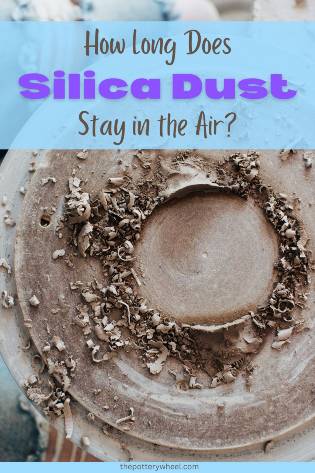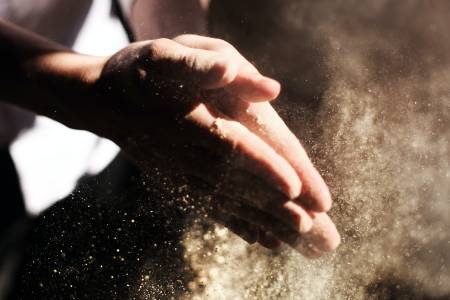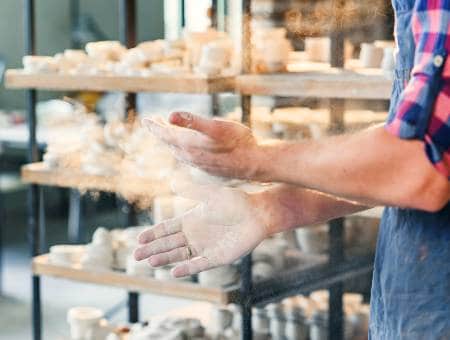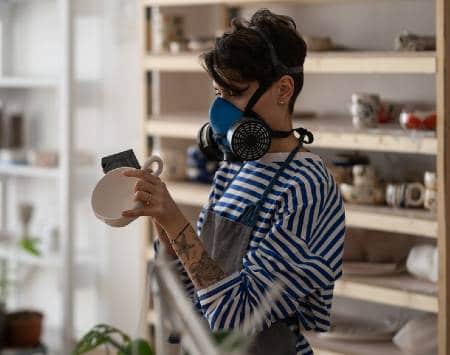Your cart is currently empty!
How Long Does Silica Dust Stay in the Air? Pottery Issues
Published:
Last Updated:

Affiliate Disclaimer
As an affiliate, we may earn a commission from qualifying purchases. We get commissions for purchases made through links on this website from Amazon and other third parties.
I always try to keep my pottery space clean and tidy so that clay dust to a minimum. But more recently, I’ve been looking a little more deeply into issues around silica dust. Some of the questions at the front of my mind were, how long does silica dust stay in the air? And what can you do to protect yourself? This is what I’ve learned so far about silica dust…
Silica Dust will float in the air for up to 12 days, give or take. The particles are very tiny. One spec of silica dust is almost 100 times smaller than a single grain of sand. Due to its size, silica dust stays suspended in the air for longer than other types of dust particles.
Unfortunately, inhaling too much silica dust is hazardous, as it causes health issues and can cause permanent lung damage. It is the major cause of silicosis, a chronic condition that is also referred to as potter’s rot (source).

This article takes a closer look at the reason that silica stays in the air for as long as it does. And what you can do to protect yourself from its effects. But first, let’s take a closer look at silica and exactly what it is.
What is Silica?
Silica is the most abundant element on the earth’s crust, and it is mostly in the form of Silicon oxide (SO2). It exists in two physical states: crystalline and non-crystalline. Primary examples of crystalline silica are sand and quartz.
Crystalline silica is pretty harmless to humans because it cannot be inhaled. When broken down, however, crystalline silica turns into respirable crystalline silica (RCS), which is respirable and, therefore, harmful.
The non-crystalline state of silica is also known as amorphous silica, free silica, or silica dust. In this state, silica is easily inhalable. Therefore, unhealthy exposure to silica dust damages the lungs and makes the lungs susceptible to a plethora of lung diseases like tuberculosis.
Silica in Clay
Clay is the backbone of pottery- it is the primary ingredient. Essentially, clay is to pottery what canvas is to painting. Clay is a mineral with a heavy composition of hydrated aluminum silicates. Thus, it contains a significant amount of free crystalline silica.
Clay is not used in its raw form to make pottery pieces. Rather, dry clay is put in a mixer with water to turn it into a form that can mold easily to form different shapes.
During the process, crystalline silica breaks down into fine, almost invisible particles that are easily respirable. Therefore, the prolonged inhalation of clay materials can cause lung damage.

Silica in Glaze
Glazes are used to color and finish clay pieces. It seals and protects fresh pottery, rendering it functional and enhancing aesthetics. Glazes comprise four main components – silica, fluxes, colorants, and alumina- where silica is the most abundant component.
The weighing and mixing of glazes reduce crystalline silica into small, respirable particles. Chronic inhalation of free silica can lead to silicosis.
Airborne Silica Dust
Because silica dust is so tiny, it stays suspended in the air for longer than other types of dust particles.
Once it is settled in the air, it is wise to leave it be, as disturbing it will render the dust airborne for an additional four hours. The longer it stays in the air, the higher the likelihood of inhaling it.
Effects of Inhaling Silica Dust on Potters
Silica dust is toxic to humans as it has hazardous health effects when inhaled. Inhaling a controlled amount of silica dust for a short time may not have any serious consequences. However, the prolonged inhalation of large amounts of silica dust causes silicosis, otherwise known as potter’s rot.
Silicosis is a condition characterized by permanent scarring of the lungs. By that definition, silicosis is a type of pulmonary fibrosis. The condition develops when fine particles of silica are deposited in the lungs over time.
Symptoms of silicosis include dry coughs, wheezing, chest pains, and emphysema. The condition also makes the lungs susceptible to infections like tuberculosis, bronchitis, and other autoimmune disorders. It also increases the chances of contracting lung cancer, especially if a person is a smoker.
While silicosis can manifest itself a few weeks after the first exposure, it usually takes many years for the effects to be experienced. It can even take up to thirty years of constant exposure to silica dust before the first symptom shows.
Since lung damage is irreversible, silicosis often leads to death. There is no cure for the disease, but there are treatment options to slow down the effects.

Avoiding Silica Dust When Using Clay and Glazes
As stated earlier, silica dust lingers in the air for about twelve days, which is equal to two workweeks and then some. Since it is a common component in clay and glaze, exposure to silica in a pottery studio is almost inevitable.
Therefore, it is vital to practice safety measures to prevent suffering the effects of prolonged inhalation of silica dust.
1) Wearing Protective Equipment
You ought to wear personal protective equipment (PPE) when working in an environment laced with silica dust. A high-efficiency particulate air (HEPA) filter mask or a respirator is a must-have when mixing clay or spraying and sanding glazes.
A respirator is built to keep particles of silica dust at bay by filtering them from the air during inhalation. There are different standards of respirators depending on their assumed protection factor: P1, P2, and P3.
It’s unrealistic to suggest wearing a respirator all the time in the studio. But it’s essential to wear one if you are doing activities that create a lot of dust, like sanding or airbrushing. Whenever possible it’s a good idea to take dusty jobs outside and do them in the open air rather than inside.
Additionally, it is safe to put on aprons when practicing pottery. They prevent direct contact with silica dust. You should opt for materials that do not absorb dust particles. Thus, get plastic or vinyl aprons instead of those made with cotton and other porous materials.
Whatever you do, ensure that your protective gear is fitting. Particles of silica dust are extremely fine, so they can easily penetrate through small spaces.

2) Keep the Pottery Studio Clean
You ought to keep the pottery studio hygienic and tidy. So, clean as often as required. Avoid sweeping because it will raise dust in the room and beat the whole point.
Instead, keep the place wet when cleaning. You could use a wet mop or wetvac to do the cleaning. The most effective way to clean a pottery studio is by using a vacuum with HEPA filter.
3) Use Premixed Clay
If you have the option, get clay that is already mixed. Not only will this save you the trouble of doing it yourself, but it will minimize the amount of silica dust in your environment.
If you have to do the mixing yourself, ensure the mixers are equipped with local exhaust ventilation to eliminate fine silica specks in the air. Also, opt for “low free silica” clay and glaze bodies to work with.
4) Make Sure There is Enough Air Circulation
A well-ventilated room promotes the exchange of dusty air with fresh air throughout the day.
Air circulation enhances the chances of clay particles with silica dust flowing out of the room and being replaced with clean, fresh air. Therefore, free silica will not be in the room long enough to be inhaled in dangerous quantities.
Better still, use a HEPA filter air purifier, like this one.
5) Avoid Consuming Edibles in the Pottery Studio
Refrain from eating, drinking, and smoking while mixing clay or glazes. Consuming things in the pottery studio increases the chances of ingesting or inhaling silica dust.
Furthermore, for you to eat or drink anything means you would have to remove your respirator. Without the respirator or a mask, you increase your exposure to silica dust floating in the air.
Pottery Studio Safety
The National Institute for Occupational Safety and Health (NIOSH) focuses on research about workplace safety and the prevention of work injuries. As per NIOSH, pottery is one of the professions with high cases of silicosis because of the relatively high exposure to silica dust.
The NIOSH recommended exposure limit (RELs) for crystalline silica is 50 micrograms per cubic meter of air as time-weighted averages (TWA).
This means risk is reduced if you are exposed to no more than 50 micrograms per cubic meter of air for a 10-hour work day. Assuming you are working a 40-hour week (source).
Final Thoughts
Silica dust particles are extremely tiny, so they tend to float in the air for longer than other types of dust particles. Essentially, they stay in the air for up to 12 hours or more if disturbed. The continuous inhalation of large amounts of silica dust poses a safety hazard as it causes silicosis, a condition characterized by permanent lung damage.
According to NIOSH, potters are among those professionals that are likely to contract silicosis. This is because both clay and glazes contain free silica, which is bound to float in the pottery studio. As a preventive measure, the NIOSH has specific recommendations about what level of exposure begins to pose a risk.
If you are working in your pottery studio, it’s hard to get a sense of exactly what these guidelines mean in practice. Following some of the suggestions above will help keep levels of airborne silica to a minimum. And reduce the amount of time the silica dust is lingering in your pottery space.



